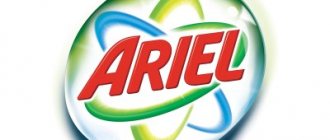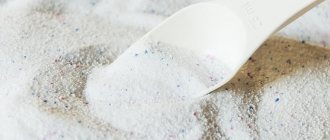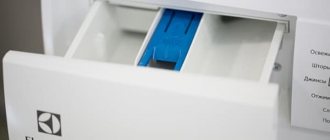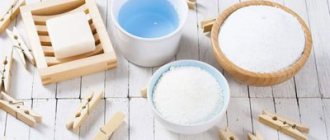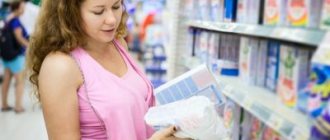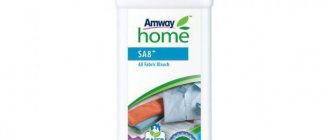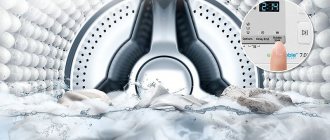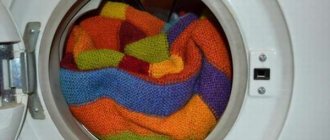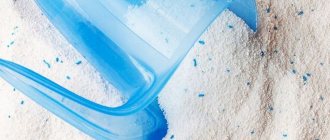In the household chemicals market, the lion's share of shelves is occupied by ordinary washing products: powders, capsules and liquid gels, and only a small part of the shelves is occupied by eco-chemicals. Such products have not received widespread advertising, which is why many buyers bypass them, choosing the usual ones.
Why fall victim to advertising and the harmful effects of harmful chemicals? If you know the composition of the washing powder, you can choose the safest one for washing clothes. Next, we'll look at what chemical and natural products are made from so you can make an informed choice.
Washing powders and their television images
In the age of advertising, it is not products that are sold, but their images.
Better than others are television images. Of course, there are few sensible people who, when forming their consumer preferences, would consciously be guided by the advice of characters from commercials. Moreover, many are only annoyed by the intrusiveness of television advertising, so much so that at the first hint of it, they rush to switch to another channel. Others convinced themselves that they had learned not to see advertising point-blank and therefore not to react. Sociologists, however, state: we make up to 90% of purchases, often without even realizing it, under the influence of advertising. And in fact, if advertising weren’t so effective, would businesses invest SO much money in it? One of the most aggressively advertised products is washing powders. This is understandable: their offer is huge, and in order to sell, manufacturers have to rub elbows a fair amount in the advertising field. IMAGES FOR SALE! What is a good washing powder? First of all, the detergent must be safe. After all, these are “chemicals”, and if the manufacturer does not comply with mandatory safety requirements, detergents can harm the health of the consumer not only when using them during the washing process, but also when subsequently wearing items washed with them. The fact that washing powder does not pose a danger to consumer health is evidenced by the Mark of Conformity on its packaging (confirmation of the conformity of washing powders is mandatory and is carried out in the form of a declaration). However, on counterfeit products, which are dangerous, as they say, by definition, it is applied, of course, without a twinge of conscience or any reason. It’s easier to run into a fake if you buy powder in a plastic bag: you won’t be able to install a line for packaging into boxes in every basement. There are cases when even... marble chips were passed off as washing powder. In short, when purchasing washing powder, do not forget about the increased potential danger of detergents.
Safe does not mean quality
Checking quality indicators (for example, does it wash well or not?) is not included in the format of confirming compliance with safety requirements. So the information “The product is certified,” often used in advertising, only means that it has passed the mandatory safety confirmation procedures. No more. This information should not be taken as confirmation of high quality. Quality
is a market category. It is assumed that each consumer must choose for himself a product that is optimal in terms of functionality and price. The only problem is that advertising is almost the only source of information about quality for the consumer. Advertising is just advertising. An industry of images that we begin to mistake for goods. Tests leave no doubt that aggressively advertised detergents are far from always superior in effectiveness to cheaper ones that are not popular in advertising and therefore go unnoticed by us. And there is no sensation in this, because, from a chemical point of view, all washing powders, no matter how much they cost, consist of the same components.
We look at the composition and draw conclusions
The main components of the washing powder are indicated on its packaging.
- Surfactants (surfactants). These are some kind of synthetic “soaps”. Water-soluble surfactants, as washing agents, are the main component of synthetic detergents and are contained in them in predominant quantities.
- Bleaches
Washing white laundry necessarily requires the presence of a chemical or optical brightener in the powder. Chemical bleaching is usually achieved by introducing chlorine-containing substances or peroxides, which destroy colored stains, mainly of plant origin (wine, tea, coffee, grass, etc.). Chlorine bleach is quite aggressive. For allergy sufferers, it is wiser to use more gentle oxygen-containing agents to remove plant stains and disinfect linen. Avoiding the word “bleach”, which alarms consumers, their presence is often masked by the term “Active oxygen” or “Oxygen power”. Optical brighteners are fluorescent substances (so-called white dyes), which, when particles settle on the laundry, give it brightness and whiteness, creating the illusion of special cleanliness. Bleach may be included in laundry detergent for colored fabrics. Should not be included in baby powders.
Phosphates
Increases the effectiveness of surfactants.
Due to what? Due to water softening. The softer the water, the less the formation of lime foam and scale, the more effective the cleaning ability of the washing powder, the higher the quality of washing, the less product is consumed. How to deal with water hardness? For many decades (since the 20s of the twentieth century), the role of softeners was played by phosphates, which bind calcium and magnesium ions and thereby soften the water in which clothes are washed. Until the early 70s of the last century, phosphates were considered the optimal component of synthetic detergents and did not cause much concern. But since then, phosphates are irrevocably a thing of the past! What didn't they like? A burden on the environment! The environmental consequences of the influence of various aspects of human economic activity on natural bodies of water greatly worried Europeans when the Rhine “suddenly” turned, as they said then, into “the sewer of Europe.” When the “roasted rooster” took the bait, phosphate-containing detergents were also suspected, and rightly so. When phosphates get into water bodies with waste soap solution, they “fertilize” them, promoting accelerated plant growth, and, as a result, lead to their overgrowing and waterlogging. Of course, phosphate-containing detergents are far from the main anthropogenic source of phosphates entering our environment. How can washing powders compare in terms of environmental consequences, for example, with the use of phosphates in agricultural production?! But, be that as it may, they certainly make their contribution. First of all, the negative impact of phosphate-containing detergents on the environment has become obvious in Europe - due to its “crowding” and a record high share of synthetic detergent use per capita. Debates about whether the phosphate content in synthetic detergents should be regulated (prohibited, limited) have been going on at the pan-European level for many years, but even in Europe, uniform requirements have not yet been developed or regulated. So for now, the countries of Europe and the world community as a whole are deciding for themselves what to do. The furthest advanced countries are Germany, Italy, Sweden, the USA, Canada and Japan, which have adopted national or industry standards regulating phosphate content. Some states have introduced legislative bans or restrictions, while others have democratically but persistently promoted and encouraged voluntary cessation of their use.
Zeolites
As a result of the implementation of environmental policy in a number of the most environmentally advanced Western countries, a transition was made to the second generation of components that bind calcium and magnesium ions.
Phosphates for water softening have been replaced by environmentally friendly, phosphate-free, insoluble zeolites. But systems based on phosphate-free insoluble zeolites did not become a panacea, and their lifespan was short-lived. The point is that the key word here is “insoluble.” And this “coin,” like all others, has two sides. Without dissolving, zeolites do not merge with soapy water into reservoirs, but, which is also not healthy, they are not washed out of the tissue structure, and, accumulating, make them rough. How critical this is for adults is up to the adults themselves to decide, but powders with zeolites are not suitable for washing children's clothes. Another disadvantage is that zeolite particles settle in sewer pipes, which inevitably leads to worse drainage. In Russia, systems based on phosphate-free insoluble zeolites have not yet appeared. In the 90s, we clearly had no time for this - much more pressing problems were on the agenda! But now there are optimistic signs that we are given the opportunity to no longer trail behind the rest of Europe, but to immediately jump into the next “wagon”, moving along the path of developing environmentally friendly detergents. We will discuss below what components phosphates are being replaced with in the 21st century.
- Enzymes
This is how enzymes are usually designated on packaging. These are biologically active substances that, by promoting the breakdown of proteins, effectively remove biological contaminants such as stains from eggs, blood, cocoa, milk, wine, proteins included in food products (sauces, ice cream, etc.). Enzymes cannot withstand temperatures above 50°C, so it makes no sense to use such a powder when washing with boiling.
- Polymers
Polymers are agents that hold washed dirt in a powder solution and thereby prevent it from re-depositing onto the fabric.
- Flavors
Gives a pleasant smell to powder and washed clothes.
- Softeners
Lanolin and other softeners, as well as additives that prevent deformation of products and maintain their shape, are included in products for delicate fabrics (lace fabrics, cambric, knitwear, microfiber, fabrics made from mixed synthetic fibers, etc.).
- Defoamers
Abundant foam, contrary to popular belief, is not always a sign of the quality of the detergent. For automatic washing machines, it is strictly contraindicated, since it not only worsens the washing result, but can also lead to a short circuit in the electrical circuit of the machine and its failure. Therefore, to prevent excess foam, defoamers are added to powders intended for washing in automatic washing machines.
- Baby powders
The information “Baby powders” on the packaging should ensure that these detergents do not contain enzymes, zeolites, or any bleaches. To neutralize unpleasant odors, fragrances and fragrances may be present, but they work only at the washing stage and do not have a subsequent effect. Liquid is considered the best solution.
- Powders for colored laundry
May be designated "Color". The composition contains polymers designed to prevent the dye from removing and, if this does happen, to keep it in solution to prevent coloring other things. These may be components such as “Paint stabilizer”, “Color protection system”, “Dye transfer inhibitor” and others.
Organic fabric conditioner
When washing, conditioners are often used to soften fabrics. We present to our attention organic conditioners:
- Vernel - products are developed on the basis of cationic surfactants that are safe for the environment;
- Lenor - environmentally friendly conditioners that soften fabrics, add freshness and antistatic properties, and increase the wear resistance of things;
- Eared Nian - a product containing extracts of lavender, aloe and cashmere, suitable for both adults and children;
- Cotico - conditioners soften things, preserve color and quality, are hypoallergenic and safe. Gives laundry a pleasant aroma;
DIY cooking
You can prepare eco-friendly fabric softener at home:
- before washing, add 100 ml of vinegar and a few drops of essential oil to the conditioner compartment;
- mix 1 liter of water, 140 ml of vinegar, 0.5 cups of baking soda. Mix everything and add 120-140 ml when washing;
- Mix 600 ml of water with 300 ml of vinegar and 200 ml of natural hair balm and mix. use 150 ml per wash.
Popular articles
- Using natural face cream: advantages and disadvantages, DIY preparation Our skin needs constant care to maintain it in a blooming state. And there’s no way around it...
- Making natural soap with your own hands at home It’s no secret that natural handmade soap is better than regular store-bought soap. But the reasons why...
- Making natural shower gel: how to make your own products for adults and children, top best brands For daily body care, especially after a hard day at work, you want to choose a natural product with…
How to choose washing powder
Choose detergents according to the type of fabric and type of stain. Their main characteristic—the cleaning effect—depends, in essence, on the careful selection and mixing of the above components and their chemical purity. This is where the scope for know-how begins. Expensive powders contain several types of enzymes, each of which specializes in removing a specific, “own” type of stain. Therefore, powders can differ significantly in the cleaning ability of various contaminants, depending on their chemical formula. The main thing for the consumer is to be sure that the washing powder meets the purpose, efficiency and cost-effectiveness that the manufacturer promises in the information provided on the packaging. And only independent tests can guarantee the accuracy and completeness of the information provided by the manufacturer to consumers.
Tests are not a wash
Functional testing of washing powders is a rather complex procedure, which not all organizations that declare themselves competent in this area can do.
But it may seem that nothing is simpler than finding out which powder does the laundry better: if you don’t believe Aunt Asya, wash it and compare it yourself. But doing laundry is not a test. To compare the effectiveness of washing powders objectively - not in sensations, but in numbers! — it is necessary to establish the actual, numerical values of their cleaning ability. Washing ability, that is, the ability to remove dirt, is the main functional characteristic of detergents. It can be measured extremely accurately by comparing the optical properties (reflectance) of a tissue sample. However, the effectiveness of washing is determined not only by the quality of the powder itself. The result is ensured by the action (and interaction!) of a number of factors. This is a chemical effect on the laundry being washed (provided by the washing powder itself), mechanical effect (provided by the washing machine), water and temperature. So it turns out that with the same powder, laundry can be washed better or worse, depending on the action of each of the washing factors separately and their interaction. The purpose of the tests is to identify the effectiveness of one or another specific factor (depending on the task), as they say, “in its pure form” on the washing result. But in order for the tests to be recognized as correct and their results comparable, it is necessary to provide technological conditions that distinguish qualified tests from an ordinary “wash”. Let's start with the fact that samples of “experimental” tissue must be of the same type, composition, size and, most importantly, absolutely equally contaminated. That is, we need samples of standard contaminants. In Russia, strips (the so-called standard contaminants for the chains for determining the detergency of laundry detergents), which would be recognized in the world, are not yet produced. This is a product of high technology, almost surpassing in complexity those used in the most high-quality painting. There are countless companies in the world that have mastered the production of standard pollutants. Rostest-Moscow uses standard contaminants produced by the EMPA Institute (Switzerland) and the VFK Institute (Germany).
Further.
If comparative tests are carried out between two detergents, two machines running in parallel are needed. And they must work, as they say, “neck to neck,” “in one breath,” so as not to give any of the tested powders the slightest head start with the benefits of their effectiveness. The Rostest-Moscow test bench is based on extremely stable Miele washing machines. The equipment for recording temperature, water consumption and other parameters, which is additionally equipped with washing machines, allows you to keep your finger on the pulse of the testing process. The recording equipment turns washing machines into test benches. The detergent is poured in strict accordance with the type and weight of the items being washed and weighed to the nearest hundredth of a gram. If there is at least a gram more of one powder, then its activity will be higher, and therefore, the result will be predetermined not by quality, but by quantity. An important parameter is the water temperature: a difference of even a few degrees, seemingly insignificant from the point of view of household washing, certainly leads to an increase in the effect of individual components of the washing powder, a reduction in the time of chemical reactions and, as a result, a distortion of the results.
Maintaining the parameters of the strictly regulated physical and chemical composition of water in both machines is ensured by a water treatment unit. And the washing time is synchronized to the second. Even the loading of the machines is done “one by one”: if in one of them the test sample of fabric is placed with a fold towards the hatch, then in the other it should be laid only in this way and in no other way. At the finish line, to determine the degree of washability, a measuring complex is used, which includes a spectrophotometer - an optical device that, based on the reflectance coefficient, determines how much lighter the fabric has become after washing, as well as a computer with the appropriate software. The technique captures, making “visible”, those numerous color transitions that are not perceived by the human eye. The use of mathematical statistics helps to eliminate the influence of random factors on the result to the maximum extent: data processing in accordance with the Fisher test, accepted in world testing practice, leaves no doubt about the reliability and objectivity of the assessment of the washability of a particular stain. Only the fulfillment of these conditions ensures the comparability of test results and turns “post-washing” into qualified tests.
Information given by the manufacturer
World-class manufacturers who value their reputation, as a rule, provide complete detailed information on the composition.
They also indicate:
- Your contact information.
- Storage requirements.
- Order of use.
- Purpose.
- Best before date.
- Date of manufacture.
An example of comparative characteristics of the compositions of some popular washing products is presented in the table:
You can trust the information on the packaging of products from well-known manufacturers who value their reputation. The inspection is carried out by regulatory state bodies of the Russian Federation .
WATER:
- moisturizes the fabric
- dissolves washing powder
- washes away and removes dirt
- conducts heat
Not everything is new - just a remake of the old
In order not to lose in competition, commodity producers are faced with the need to introduce a new product to the market as often as possible.
It is in the “News” segment that the frontline of the struggle for the consumer lies, to whom you always serve something fresh. Technological progress, however, does not keep pace with the unbridled desire of the manufacturer to constantly amaze its consumer with something new. You can’t get enough new products in such quantity, and manipulations with “re-facing” are used: not newly created products are presented as such by cleverly giving them a new face, image. And it passes! The deception, in general, is not great, but it is a deception! So, without a twinge of conscience, a product that has been on the market for a long time is passed off as “revolutionary new”, but... with a slightly changed name, in new packaging, and, naturally, at a new price! We are, of course, not just talking about washing powders. This technique is “Everything new is just a remake of the old!” – universal in marketing. Cosmetic “rejuvenation” of products that set the teeth on edge is presented as a change in the model range with a corresponding increase in price. But in reality it turns out that a familiar and cheaper product from 2-3 years ago is no worse than such a “super new product”. Washing powders belong to that category of products in which it is especially difficult to surprise with something fundamentally new, since they all consist of a set of the same components. Nothing fundamentally different has yet been invented. But there is a need for continuous improvement of quality. Manufacturers of detergents, constantly improving their quality, thereby respond to improving the quality of those products, the use of which leads to contamination of clothes and other items. The more high-quality, durable paints, hair dyes and other potential contaminants in our clothes become, the greater the cleaning power of washing powders. Such dialectics! When children drew with slate pencils, there was no need for detergents, which are now indispensable with the advent of felt-tip pens, markers, etc. Products that use strong dyes are becoming a growing problem. Today you can paint fences with other drinks (alcoholic and non-alcoholic)! An increase in cleaning power is achieved by creating a more successful composition with the introduction of additional types of enzymes, ensuring increased chemical purity of the components and special care of their mixing. This becomes possible as a result of scientific research and the introduction of high technologies.
Let's talk about tests confirming the high quality of detergents, using the example of cooperation in this direction with the Henkel company, which produces the world-famous Persil.
Persil vs Persil. Comparative tests
demonstrating respect for its consumer not in words, but in deeds, it was one of the first to begin prefacing the advertising campaign of its new products with tests in Rostest-Moscow, which should confirm the authenticity of the declared properties and qualities. The startup began testing the Persil “POWER PERSIL” AUTOMAT synthetic detergent produced by a new (at that time) formula in comparison with its own product of the previous generation. The task was to obtain documentary evidence that the new product actually has more effective cleaning power. Coffee and tea, wine and juice, grass, chocolate, dirt, hamburger grease, cosmetics, carrots, tomatoes, oil... According to statistics, it is precisely this type of pollution that we most often annoyingly stain our things with. It is clear that leading manufacturers of synthetic detergents compete primarily in removing precisely this type of stain. The comparative testing program for the new product and the prototype included 20 test cycles for 15 stains in two temperature conditions - “Cotton 40°” and “Cotton 60°”. Processing of the obtained data using the Fisher test stated that the new synthetic detergent Persil “POWER PERSIL” AUTOMAT is characterized by a higher cleaning ability: for six contaminants the new product showed a “higher” result in comparison with the synthetic detergent produced previously, and for nine - even “ much higher":
- coffee (much higher)
- tea (much higher)
- black currant (much higher)
- blueberry juice (much higher)
- young red wine (above)
- grass (much higher)
- chocolate (much higher)
- tomato puree (above)
- blood (above)
- grass and dirt (much higher)
- carrots + mashed potatoes (above)
- red wine (much higher)
- pigment + oil (above)
- cosmetics (much higher)
- colored olive oil (above)
For those who prefer handmade
For those who prefer washing by hand (as they say, “in a basin”), we present the results of comparative tests of a synthetic detergent of a new formula for hand washing SMS “Persil for hand washing (hand wash)” with a previously produced product. For six contaminations, the new product showed “higher” results, and for five - “significantly higher”:
- coffee (above)
- tea (much higher)
- black currant (much higher)
- blueberry juice (much higher)
- grass (above)
- chocolate (much higher)
- tomato puree (above)
- blood (much higher)
- carrots + mashed potatoes (above)
- cosmetics (above)
- hamburger fat (above)
So if, unfortunately, one of the above stains appears on your things, this is not yet a reason to be seriously upset: to regain the lost cleanliness, you don’t even need to bother with the washing machine. In this case, it is enough to have a basin on hand and an SMS message “Persil for hand wash”
PERSIL v. COMPETITOR
At the next stage, the task was posed more acutely: the experts were asked, as they say, to compare PERSIL GOLD, which had just appeared then, with the best analogue available on the Russian market.
Self-assessment of products based on comparison with analogues is provided for by most quality assessment models, but enterprises are extremely reluctant to do it. Competitors often prefer not to notice each other point-blank, preferring in advertising campaigns to risklessly compare their products with some abstract, hypothetical (even such a definition has appeared!) analogue, slyly called “ordinary”. Perhaps this is the first time that a manufacturer has offered to conduct an independent examination of the quality of its products in comparison with a truly real and strongest analogue on the market. The goal was by no means to “put down” a competitor and build their PR on such anti-advertising - this would contradict the ethics of this kind of comparative testing. Therefore, what kind of powder was used for comparison was not made public. But experts guaranteed that this was not some hypothetical analog convenient for comparison, but a very real competitor of the same class, “weight category” and price range. The CMC Persil Gold sample, in comparison with the analog sample when washed in automatic drum-type washing machines on the “cotton 60°C” program, after processing the results according to the Fisher test, showed significantly better washing ability for the following contaminants: Textile base “Cotton”:
- red paint for painting.
Textile base “Mixed composition (polyester 65% and cotton 35%)”:
- rust
- markers (orange, pink)
- hair dye (chestnut N3, medium blond N6, silver blond C10, black N1)
- paint for painting (red, green).
Textile base "Polyester":
- rust,
- markers (orange, pink, green)
- hair dye (fire red R15, dark chestnut N2, chestnut N3, medium blond N6, pearl blonde A10, silver blonde C10, black N1)
- paint for painting (yellow, red, green),
- coffee (CFT BC-2),
- tea (CFT VS-3),
- black currant (CFT CS-12),
- blueberry juice (СFT CS-15),
- red wine (CFT CS-103),
- chocolate drink (CFT CS-44).
What standard gold PERSIL
Among the “experimental” detergents was PERSIL GOLD PLUS powder.
Its fundamental feature is that it is environmentally friendly - it does not contain phosphates, which are replaced by a special modified system of components that effectively work against hardness salts and at the same time dissolve in water without any problems. Before releasing a new environmentally friendly product onto the market, the manufacturer decided to answer, as they say, the question that naturally arises among consumers: will it be worse in cleaning ability than its predecessor, albeit less environmentally friendly? The question, frankly speaking, is a burning one. In theory and in words, we are all sincerely for the environment! Under one condition, however: if it doesn’t cost us anything personally! If you need to take an extra step to get to the ballot box, the piece of paper ends up on the sidewalk. And if the most environmentally friendly powder turns out to be not as “washing” and less economical than a non-ecological one, then it will simply become uncompetitive. This, unfortunately, is the logic of the market. In short, consumers should be confident that by switching to an environmentally friendly detergent, they will not lose in the quality of their laundry. In order not to be unfounded in promising statements, the Henkel company proposed to Rostest-Moscow to conduct an examination of the general cleaning ability of the powder of the ecological formulation PERSIL GOLD PLUS and, based on its results, confirm or refute the manufacturer’s claim that it is functionally not inferior to phosphate-containing products. Tests have shown: PERSIL GOLD PLUS of the phosphate-free formulation is not inferior to either its predecessor or the strongest analogues (its name is not disclosed, as required by professional ethics).
Liquid
To prepare liquid laundry detergent, you will need a saucepan and water.:
- Grate 1 piece of laundry soap, place it on the bottom of the pan, cover with water and cook over medium heat until smooth;
- add water to half the pan, add 1 cup of soda ash, 0.5 cup of borax, stir;
- add water and leave to cool overnight with the lid closed;
- Add essential oil to the cooled mixture.
Using such powders is quite simple. The product is added to the drum of the machine or to a special compartment for powder, at the rate of 1-2 tablespoons per 2-3 kg of items.
Test 1
Persil Gold Plus, in comparison with its predecessor Persil Gold, when washed in the “cotton 30°C” program, showed significantly better washing ability against the following stains applied to 100% cotton textiles:
- chocolate drink (CFT CS-44).
- cherry juice (B&J)
- chocolate ice cream 1 (Asda)
- chocolate ice cream 2 (Carte D'or)
- chocolate ice cream 3 (Vienetta)
- raspberry juice (Del Monte)
- chocolate milkshake (Frij)
- raspberry ice cream (Tesco)
Dry
To prepare dry powders, dry laundry soap, grated on a fine grater, is used. All necessary components are mixed, at the last stage a few drops of essential oils are added, mixed and placed in an airtight container.
Recipe 1:
- 150 g dark laundry soap;
- 500 g regular soda;
- 400 g soda ash;
- essential oil.
Whitening Powder Recipe:
- 1.5 cups of laundry soap;
- 1 cup soda ash;
- 0.5 cups baking soda;
- 1 cup borax;
- a few drops of aromatic oils.
Recipe 3:
- 2 pieces of crushed laundry soap;
- 1 cup baking soda;
- 1 cup soda ash;
- 2 tablespoons of vinegar (3 or 9 -%);
- essential oils (essential to eliminate the strong smell of vinegar).
Experts advise
- As we have already said, automatic washing machines are designed to use low-foam washing powders. Therefore, when washing with an automatic machine, do not use detergents intended for hand washing, which are specially made with increased foaming. Choose powders that show either a front-loading machine or a loading hatch on the packaging. The word "matic" may be used to refer to reduced foaming powders.
- Keep in mind that increased foaming with all the ensuing unpleasant consequences also results from exceeding the dosage recommended by the manufacturer, even of special, “correct” washing powders. So, when using the powder for the first time, even if it says that it is intended for automatic washing machines, but does not provide dosage recommendations, we advise you to make sure that the level of foam during washing is not higher than the top edge of the hatch (in front-loading machines ). Otherwise, it would be wiser to refuse to use it in the future.
- If the machine is not fully loaded, reduce the amount of detergent accordingly.
- Liquid detergents are used for washing at temperatures not exceeding 60 °C. Their use eliminates the use of a pre-wash cycle, so the amount of detergent recommended on the package applies directly to the main wash cycle.
- When washing in cold water, reduce the amount of detergent: since it dissolves less readily than in hot water, some of it will be wasted.
- Particular attention should be paid to children's washing powder: often the instructions for use recommend pouring children's washing powder directly into the drum directly onto the laundry, and not into a ditch, like ordinary powders.
- It is better to dilute the conditioner with water, since it is usually thick and the washing machine does not remove it completely.
GOST
All detergents are produced in accordance with standards and specified norms. One of the main regulatory documents is GOST.
, substances whose occurrence is more than 0.2% of the following components
are mandatory for inclusion in the information on packaging
- Surfactant
- Phosphates and phosphonates.
- Polycarboxylates.
- Zeolites.
- Soap.
- Oxygen-containing bleaches.
- Some types of acids and salts.
The manufacturer must indicate the percentage of components, taking into account the range:
- 30% or more;
- from 15 to 30%%
- from 5 to 15%;
- up to 5%.
also be indicated in the composition (regardless of the mass fraction):
- optical brighteners;
- disinfectant components;
- enzymes;
- preservatives;
- fragrance
Compliance with GOST requirements is mandatory for manufacturers. Find out more here.
Choosing a good remedy
When buying powder, use the following tips:
- Be sure to check the composition of the detergent. If it is written in small, smeared font and in a foreign language, refuse this option;
- the packaging of the washing powder must be completely sealed;
- Feel and even shake the pack to make sure there is loose laundry detergent inside. The presence of lumps indicates that the storage of the powder was organized improperly;
- There should be no strong odors. If they are felt, the composition contains a large amount of chlorine components that are harmful to the body.
Remember that only high-quality powder washes clothes well.
Oxygen washing amplifier CHISTOWN
The universal oxygen washing amplifier CHISTOWN is recommended for washing and soaking children's clothing, bed linen, and for cleaning carpets and upholstered furniture. It is safe for the skin, does not spoil things, and does not discolor fabrics.
Washing enhancer CHISTOWN removes most types of stains.
CHISTOWN oxygen wash enhancer safely whitens white items and preserves the colors of colored items with regular use.
The CHISTOWN oxygen washing enhancer can be added to any of the CHISTOWN washing powders with each wash.
The oxygen washing amplifier CHISTOWN allows you to effectively remove stains from grass, blood, brilliant green, iodine, wine, mold, food, juices, as well as stains from resins, oils, etc.
What is optical brightener?
The name of this component speaks for itself. Optical means creating a certain visual effect. In other words, an optical illusion. It consists in the fact that the surface looks whiter than it actually is. In fact, the composition of optical brightener is an organic dye that allows brighter reflection of the rays of the violet-blue part of the spectrum. This masks the yellowness of white fabric that inevitably appears after repeated washings, but it does not make the fabric cleaner. Optical brighteners are fluorescent substances, so they show their effect in daylight and under ultraviolet rays.
What to look for when choosing
Before purchasing such products, we advise you to look at several purchasing recommendations.
- Compound. It is a priority to purchase a stain remover that does not contain synthetic components; this choice will be the most correct, especially if you have children, since such bleaches do not cause peeling of the skin, redness and itching.
- Release form. There are powders, gels and sprays. The first option is convenient when washing by hand; liquid bleach is recommended for use in a washing machine, and a spray can be used to remove stains on the go.
- Expiration dates. Expired products can have a negative impact on your health.
We all want to look good, because, as the famous proverb says, people are greeted by their clothes. Impeccable appearance is the key to half of our success. Often, after several washes, white clothes look not so white, lose their attractive appearance, and we throw them in the trash. To make it easier for housewives to maintain brightness during hand and machine washing, manufacturers offer oxygen, optical and chlorine-containing bleaches. Nowadays, there are bleaches even for colored items.
Attention to phosphates
Phosphorus compounds have an extremely negative effect on the condition of human skin - this theory has already been proven by various scientists and researchers. Such substances, used in excess, can destroy the natural protection of the skin. As a result of the negative effects of such drugs, the human body can develop:
- Dermatological pathologies, for example, diathesis, dermatitis, etc.
- Allergy
- Metabolism problems
- Respiratory tract lesions
It is worth understanding that phosphorus compounds can easily penetrate the skin into the bloodstream and spread throughout the body. Such components are often found in dishwashing liquids. Their concentration here is small enough to cause burns to the mucous membranes, but your hands should be additionally protected. Always wear gloves when washing dishes. And after washing it should be rinsed thoroughly.
To eliminate the negative effects of various chemicals included in household chemicals, experts recommend ventilating the room during and after cleaning, and washing the floor after washing clothes. You need to choose products that are certified, do not have a strong odor (this point does not apply to chlorine-containing preparations), and are packaged in sealed packaging. The products cannot be mixed with each other, because it is unknown what reaction they may give. To protect yourself, in addition to gloves, you should also use a face mask.
What is optical brightener
The operating principle of optical brightener, which can also be called fluorescent, is the reflection of light rays. When washing a product, the bleach is not completely rinsed out; its remaining particles create the illusion of whiteness when light hits the clothing.
The prototype of modern optical brighteners was blue, which has been used in all laundries for many decades. In fact, the snow-white appearance of the fabric is achieved not due to its purity, but due to reflective substances and dyes.
It is not easy to buy pure optical brightener in household chemical departments; it is often found in other detergents. All powders for white laundry contain bleaching substances in different proportions. Oxygen stain removers for white laundry also contain an optical option (Vanisn Gold or Vanish Crystal White, K2r, Heitmann Bleaching Agent and others).
Optical brighteners are strictly prohibited for washing children's underwear and clothes.
After washing or soaking items in such a product, things actually look several shades whiter, but this method of achieving a flawless look is fraught with many disadvantages. First of all, an allergic reaction.
Since the optical agent always remains in the fabric, it comes into contact with the skin and can cause allergies. Optical brighteners should never be used to wash children's clothes!
Features of using bleaches for various fabrics
When choosing bleach for white or colored laundry, pay attention to the recommendations for washing various fabrics
- Natural cotton fabrics (linen, cotton, chintz) will perfectly withstand the effects of any type of brighteners - with or without chlorine. Soaking, boiling, hand or machine washing - any method will give excellent results. An exception should be made only for painted items. To maintain the brightness of color pigments, it is better to use oxygen preparations and machine wash at 40 degrees.
- Wash silk, wool, delicate items, synthetic fabrics with oxygen-containing products that do not destroy the structure of the fabric. Select the washing mode in accordance with the recommendations on the item's label.
- Children's clothing and bedding are not recommended to be bleached with chemicals or optical brighteners. A child's skin is delicate and sensitive to aggressive substances. It is better to boil pre-washed diapers with baking soda and shavings of laundry soap.
Homeenpoisto (Tikkurila)
It is convenient to treat large surfaces with Homeenpoisto from a garden sprayer.
Finnish-made hyperchlorite solution, a leader in its price group. Sold in 1 and 5 liter containers. Among the advantages:
- universal, whitens wood, tiles, concrete and plastered facades;
- eliminates mold and other types of fungus, prevents subsequent infections;
- copes with deep pollution;
- economical (dilution with water in a ratio of 1 to 3 is recommended).
The solution can be applied with a brush or sponge; after treatment it must be rinsed off. The price of a liter package is from 340 rubles.
Range
Some types of detergents are positioned as universal for two or three types of cleansing (3 in 1, 2 in 1). A product called “Myth” from Procter & Gamble, according to the manufacturer, is suitable for removing stains from clothes, washing dishes and cleaning tile surfaces. The consumer must understand that bleaching delicate terry cloth and removing plaque from bath enamel are completely different tasks. The components of modern powder, although they have a versatile effect, are not able to cope with two multidirectional actions at the same time. A powder that can make tiles shine can damage thin fabric.
An excellent marketing ploy is to create a specific powder for equipment from a specific manufacturer. For example, Ariel automatic washing powder, according to the manufacturer’s instructions, is optimally suited for Bosh and Siemens washing machines. Perhaps there is still some truth in such “recommendations”, but a comparison of the composition with a competing analogue shows that there are no significant differences between the content of chemical substances in it.
It is extremely difficult for domestic manufacturers to compete with already promoted brands. The largest Russian concern "NEFIS" produces more than 300 items of goods under well-known trademarks - "Lesnaya Polyanka", "Biolan", "AOS", "BiMax", "Sorti", etc. At the same time, many Russian companies are coming under the control of foreign representative offices . Large chemical plants such as Era-Tosno, Northern Lights and Novomoskovskbytkhim were purchased by investors. The products they produced were “transformed” to suit imported equipment and the tastes of European consumers. According to the consulting agency CREON, there are about 65 powder production factories in Russia, and the demand for “small” scale brands is only growing
Domestic brands are “cautiously” squeezing out transnational analogues. For example, the Stupinsky chemical plant, widely known in Soviet times, which produces goods in the mid-price segment, was able to win 0.5% of the market (the “5 plus” line).
Most of the powders that are produced in Russia are examples of “dry mixing”. International developments find their application in domestic realities. Between an expensive powder and a middle-class powder, there is a difference in “promotion”, less often in the content of active substances and so-called ballast. For example, the already mentioned “5 plus” product from the Stupinsky plant contains 25 active components, while Tide has only 11. Mainly Russian factories produce lower segment products with a price accessible to the masses (“Zifa”, “Vesna” and etc.). A representative of the expensive segment is BiMax powder from the NEFIS concern. But “affordable” does not mean “bad” - the effectiveness and quality of domestically produced products are confirmed by GOST 25644-96 (for synthetic powdered products). Liquid washing gels in Russia are produced only by transnational concerns.
About 80% of the market for powder products used by consumers is occupied by foreign brands, and only 20% of domestically produced products enjoy the well-deserved love of Russians. Among them the most popular are:
- Procter & Gamble is an American transnational giant that produces products under the brands Tide, Ariel, Tix, Dreft, and Myth. The profit of the corporation, which occupies 44% of the industry, is more than $3 billion per year (and this is only for the Russian consumer);
- Henkel is a German chemical concern that produces products under the brands Persil, Losk, Deni, Laska and Pemos. Henkel holds 26% of the Russian market share;
- JSC Nefis Cosmetics is a Russian industrial company that owns 10% of the detergent market;
- Reckitt Benckiser is a multinational brand that produces products in the affordable price segment - Dosia, Lanza. Occupies about 7% of the total share;
- OJSC Soda is a Russian brand that holds 5% of the market under the Zifa trademarks and the new environmental innovation Ekol;
- CJSC Aist is a Russian enterprise occupying 4% of the market niche. Produces powders under the brands Aist, Cashmere, Kapel, Yat and Lumix;
- OJSC Nevskaya Kosmetika is a domestic manufacturer of baby powder, which holds 4% of the market. Known under the trademarks Ushasty Nyan, Sarma, Lotus, Max, Index, etc.
Approximately every fourth respondent is influenced by advertising content when choosing a product. Perhaps the low share of popularity among consumers of Russian detergents is explained by the “stingy” strategy of the mass media and their insufficient representation in retail chains.
Our body's enemy No. 3 - Optical brightener
It just illusorily makes things white. That is, it does not wash until white, but, like dust, covers the fabric with its smallest particles, which are reflected in ultraviolet light, giving the impression of purity and radiance, but, offensively, this illusion disappears under artificial lighting. This bleach is not completely washed out of the fabric, and upon contact with skin it still leads to the same disastrous consequences.
Oxygen brightener can be an excellent alternative to optical brightener. Today it is the most gentle and safe bleach on the powder market precisely because it is based on sodium percarbonate, which, upon contact with the environment, decomposes into soda, oxygen and water, therefore - biodegradable and again hurray - does not have a negative effect. By the way, it rinses well.
Now we know that if we see optical brightener in the ingredients of a powder, then let the powder live on the shelf in the store, but not in our bathroom.

